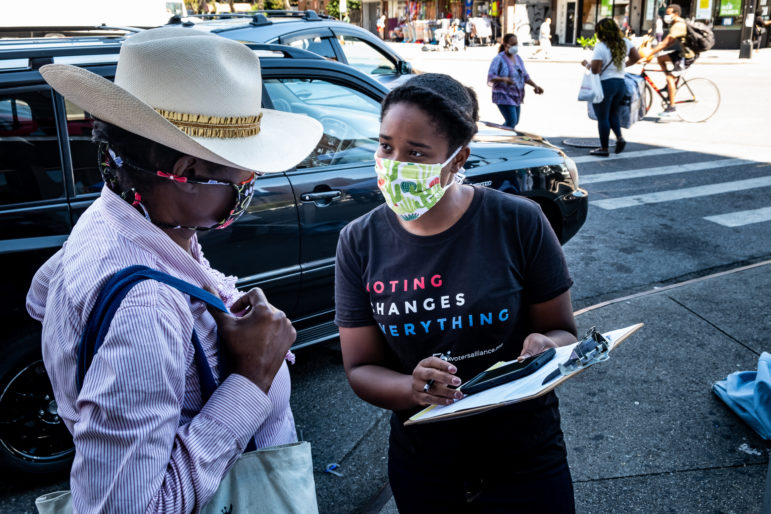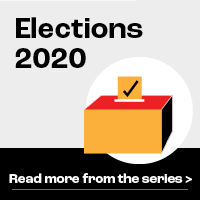Growth in the voter list is running at half the 2016 pace.

Adi Talwar
In Midwood Brooklyn, on the first Saturday of September, Brooklyn Voters Alliance volunteer Amanda speaking with a passerby about registering for voting.New voter registration across New York City has dropped by nearly half in 2020 compared to the last presidential election year in 2016.
Between January and June, only about 80,000 people registered to vote across the city, compared to 155,000 people during the same period in 2016, according to the city’s Campaign Finance Board, which regulates money in politics and promotes voter registration.
The Campaign Finance Board attributes the slower rate of signups to New York State’s limits on public gatherings due to COVID-19. New voter registration was actually ticking upward compared to 2016 before the PAUSE orders in March, according CFB’s data. A majority of new voter registrations take place in person at large public gatherings, creating a significant void for organizations that sign up new voters but have been sidelined by the pandemic.
The Campaign Finance Board also lays blame on New York’s outmoded voter registration laws, particularly the lack of an online voter registration system that would allow people to safely register from their homes. A bill that would implement such a system passed the state Senate but has not received a vote in the Assembly.
“We’re at a standstill,” says Eddie Cuesta, executive director of the group Dominicanos USA, which promotes civic engagement among the New York City’s Dominican American community. He says the group has registered just 10 percent of the people it registered in 2016.
Allie Swatek, director of policy at the Campaign Finance Board, warns the dip in registrations this year could have an impact beyond this year’s general election.
“There’s a greater opportunity to register folks in a presidential year than a non-presidential year,” Swatek says, which means upcoming local elections (the municipal contests of 2021 and the state races in 2022) could have fewer voters in the mix than they otherwise might.
While the system appears to be missing out on potential new voters, the total number of registered voters is higher than it was four years ago. According to data provided by the state Board of Elections, the total number of active voters in New York City in February was 8 percent higher than on Election Day 2016.
| Date | Total active voters in NYC |
| November 1, 2016 | 3,343,041 |
| November 1, 2017 | 3,453,869 |
| November 1, 2018 | 3,491,943 |
| November 1, 2019 | 3,581,491 |
| February 20, 2020 | 3,617,982 |
Making the pitch to new citizens
Among the more effective places to register new voters are naturalization ceremonies, where immigrants are sworn in as American citizens at federal courthouses.
Several organizations that spoke to City Limits, including Dominicanos USA, Asian American Legal Defense and Education Fund (AALDEF) and Brooklyn Voters Alliance said they were regularly registering people to vote at these ceremonies up until New York State received PAUSE orders.
Jan Combopiano is a member of Brooklyn Voters Alliance, a three-year old organization doing voter outreach, registration, education, and advocacy. Combopiano says the organization was regularly registering new voters at naturalization ceremonies until mid-March.
The ceremonies were at the Southern District Courthouse in lower Manhattan, an arrangement made by NYC Votes, a voter registration project run by the Campaign Finance Board. (Brooklyn Voters Alliance is based in Brooklyn, but the members say that borough’s Homeland Security office did not permit them to register people at naturalization ceremonies.)
Cuesta, with Dominicanos USA, also says the group has been registering new voters at naturalization ceremonies—every Friday for the past few years—and as recently as early March. Cuesta estimates the group would get 60 to 65 percent of people registered at ceremonies they attended, where about 150 people were naturalized.
Surmounting age and language barriers
Judy Lei, voting rights organizer at the Asian American Legal Defense and Education Fund (AALDEF), says the organization registered newly naturalized citizens at the Southern District Courthouse every Friday. Typically AALDEF would register about a third of those in attendance, she says.
Lei says that in-person registrations are important because volunteers can clear up any confusion potential voters may have about the process.
Often, she says, people blow off registration under the assumption they can do it online when they get home. But in New York state, potential voters still need to print out and mail a form to their Board of the Elections. This can sometimes present challenges for elderly or low-income residents of Chinatown, one of the neighborhoods AALDEF serves.
Shirley Ng, a staffer at AALDEF, has been registering voters in person in Manhattan’s Chinatown, an effort to make up for the lack of public events. On three occasions over the past six weeks, she has set up a small table on Bayard Street to pull in new voters. On each of those occasions, she signed up about 10 people. About half of those people were new voters and the other half address changes, she says.
Ng estimates about 80 percent of the people she has signed up are low English proficiency and many are seniors. Ng speaks Cantonese, and is sometimes accompanied by a Mandarin-speaking volunteer. She says that seniors and low-English proficiency people who reside in Chinatown are a population that could have trouble navigating the registration process on their own.
“You can’t register online, this is a misconception,” Ng says, underscoring the point that registration forms must still be printed out and mailed.
“The seniors, the elderly—they don’t have Internet or printers,” she says of the Chinatown residents she speaks with. “You have to go back old-school with paper or they don’t think about it.”
Sometimes conversations happen that could only occur in-person. One young man passed by her table and told her he didn’t plan on voting despite being registered. Ng tried to persuade him to reconsider. A few days later, he stopped by her table after doing just that and she helped him with an address change.
“If you’re not out there, they won’t think about it,” Ng says.
Piggybacking on protests
Brooklyn Voter Alliance has also been finding ways to register more people in person. Members says that when protests of police violence began at the end of May, the group started attending protests to register new voters. When protests diminished, the group transitioned to “pop-up” voter registration drives in different Brooklyn neighborhoods every weekend. The people who stopped to register to during the pop-up events include experiencing homelessness and people who haven’t voted in decades, the group says.
But foot traffic has been limited, even with the city at Phase 4 of re-opening. “It’s not the volume at a big crowded event, so that’s been tough,” says Brooklyn Voters Alliance member Julie Kerr. “We’ll take what we can get.”
The dip in new registration is particularly troubling for the youth vote across the city. Swatek of the Campaign Finance Board says many newly 18-year-olds didn’t register this election cycle, and many didn’t know that they can pre-register before they turn 18.
Brendan Cushing, 23, is director of programming at Generation Vote, a volunteer organization that has been registering young people to vote and advocating for the state to lift “systemic barriers” to youth voting. Cushing says that the group typically has volunteers on college campuses registering new voters, something harder to do at a time when many college campuses have been closed to prevent the spread of COVID-19. Young people are more transient than older folks, and in New York City, many do not have a driver’s license or state ID, which also makes registration a challenge, Cushing says.
For young people in particular, an online voting registration system would be a significant boon during a pandemic that has kept them more online than usual. This is why voting rights groups are frustrated that this reform has not been put in place by state legislators. The state did pass automatic voter registration this year, but it will not go into effect until 2023.
Stalled move toward online voting
The city’s Campaign Finance Board says that it has already built a city-wide online registration system that could be swiftly implemented. But in addition to the proposal’s stalling in the state Assembly, the state Board of Elections has not publicly supported such a plan. A request for comment from the state Board of Elections was not returned.
Kerr, from the Brooklyn Voters Alliance, said that refusing to pass the bill has put voting rights supporters in a difficult position, forcing them to risk their health by registering people in-person during a pandemic.
“We’re very disappointed that the assembly did not pass the legislation and leaves us vulnerable to register voters in the pandemic,” Kerr says. “Those of us happy to register voters in person are putting ourselves in harm’s way to do so, but we can’t register the volume of new voters that an online system would create.”
Combopiano added that an online system would be intuitive to the very young people they’re trying to get to vote.
“Every time we have to tell an 18-year-old they have to fill out a piece of paper, they think we’re crazy,” she says. “It feels like it’s a deliberate attempt to not have young people be registered.”
“Voting is a habit,” Combopiano added. “Having people turned away means that person is less likely to vote in the future. It’s not just this election, but about future elections.”










